Home > Daily-mcqs
Daily-mcqs 29 Apr 2025

Q1:
Consider the following statements about the Indian Cyber Crime Coordination Centre (I4C): 1. It was launched by the Ministry of Home Affairs and formally inaugurated in 2020. 2. It includes the National Cybercrime Reporting Portal and a Cybercrime Forensic Laboratory. 3. It functions under the Ministry of Electronics and Information Technology. 4. It is now authorized to share information under Section 66 of the PMLA, 2002. How many of the above statements are correct?
A: Only two
B: Only three
C: All four
D: Only one
Answer: B
Explanation:
Statements 1, 2, and 4 are correct.
I4C was launched by the Ministry of Home Affairs and inaugurated in 2020. It includes key components such as the National Cybercrime Reporting Portal, Cyber Forensic Lab, and Training Centre.
With its recent inclusion under Section 66 of the PMLA, I4C is empowered to share intelligence related to money laundering.
Statement 3 is incorrect—I4C does not function under MeitY but under MHA.
Thus, only three statements are correct.
Q2:
Which of the following plant virus control strategies involves genetically modifying the plant to produce virus-fighting RNA?
A: SIGS (Spray-Induced Gene Silencing)
B: CRISPR-Cas9 gene drive
C: RNA interference (RNAi) vaccine spray
D: HIGS (Host-Induced Gene Silencing)
Answer: D
Explanation:
HIGS involves genetically engineering the plant to produce virus-targeting dsRNA internally, offering continuous protection.
This method is effective but raises biosafety and regulatory concerns, especially for food crops.
In contrast, SIGS applies RNA externally and does not alter the plant’s DNA.
CRISPR-Cas9, while powerful, is not used here; it targets DNA-level gene editing, not RNA silencing.
Thus, HIGS is the correct answer.
Q3:
Which of the following statements about Sudan Virus Disease (SVD) are correct? 1. SVD is caused by a species of Ebolavirus that primarily spreads through airborne droplets. 2. SVD can be transmitted via contaminated objects like needles and bedding. 3. Uganda recently declared the end of an SVD outbreak after a 42-day countdown without new cases. 4. Fruit bats are believed to be natural reservoirs of Ebola viruses. How many of the above are correct?
A: Only one
B: Only three
C: All four
D: Only two
Answer: B
Explanation:
Statements 2, 3, and 4 are correct.
SVD transmission occurs through direct contact with infected body fluids or contaminated objects, not via airborne droplets—making Statement 1 incorrect.
Uganda’s 42-day countdown aligns with WHO protocol to declare an outbreak over.
Fruit bats, along with monkeys and antelope, are natural reservoirs of Ebola viruses.
Thus, three statements are correct.
Q4:
Consider the following virus classification group with its example: Group (Baltimore System) Example Virus A. Group I – dsDNA 1. Adenovirus B. Group IV – (+)ssRNA 2. Poliovirus C. Group V – (–)ssRNA 3. Influenza D. Group VI – ssRNA-RT 4. HIV Which of the above pairs are correctly matched?
A: Only two
B: Only three
C: All four
D: Only one
Answer: C
Explanation:
All four pairs are correct as per the Baltimore virus classification:
Q5:
Which of the following statements about Similipal National Park are correct? 1. It hosts the world’s only wild population of melanistic tigers. 2. It is India’s first tiger reserve to be declared a national park. 3. Similipal is also a UNESCO Biosphere Reserve. 4. It is the second national park in Odisha after Bhitarkanika. How many of the above statements are correct?
A: Only two
B: Only three
C: All four
D: Only one
Answer: B
Explanation:
Statements 1, 3, and 4 are correct.
Similipal is globally renowned for its wild melanistic tigers, which are genetically unique. It is also a UNESCO-recognized Biosphere Reserve and was recently declared Odisha’s second national park after Bhitarkanika.
Statement 2 is incorrect: Similipal was already a Project Tiger reserve and biosphere reserve before receiving national park status in 2025. It is not India’s first tiger reserve to become a national park.
Hence, three statements are correct.